Abstract
Nationwide, 45 states issue health advisories for sport fish consumers. Chemical contaminants in some Great Lakes (GL) sport fish include compounds suspected of causing adverse reproductive and developmental effects. Although advisories to reduce consumption of contaminated fish, especially by women, have been issued by GL states (i.e., Illinois, Indiana, Michigan, Minnesota, New York, Ohio, Pennsylvania, and Wisconsin) since the mid-1970s, little is known about advisory awareness and GL sport fish consumption in the general population. To estimate the prevalence of GL sport fish consumption and health advisory awareness, we conducted a population-based telephone survey of 8,306 adult residents of the eight GL states. We gathered information concerning respondents' demographic characteristics, fish consumption during the preceding year, and sport fish consumption advisory awareness. The survey response rate was 69%. GL sport fish were eaten during the preceding year by 8.4% -95% confidence interval (CI), 7.6-9.2- of adults in the GL states, approximately 4.7 million persons. Women accounted for 43.9% (CI,39. 4-48.4) of consumers. Although 49.9% of GL sport fish consumers were aware of a health advisory, awareness varied significantly by sex: 58.2% (CI, 51.7-64.7) of males and 39.1% (CI, 32.6-45.6) of females were aware. Using logistic regression, we found awareness associated with male sex -odds ratio (OR) = 2.3; CI, 1.5-3.5), white race (OR = 4.2; CI, 1.9-9.1), college degree (OR = 3.1; CI, 1.3-7.6), and consuming >=24 GL sport fish meals/year (OR = 2.4; CI, 1.4-4.3). Only half of GL sport fish consumers reported awareness of a health advisory concerning eating GL sport fish. Awareness was especially low among women, suggesting the need of targeted risk communication programs for female consumers.
Full text
PDF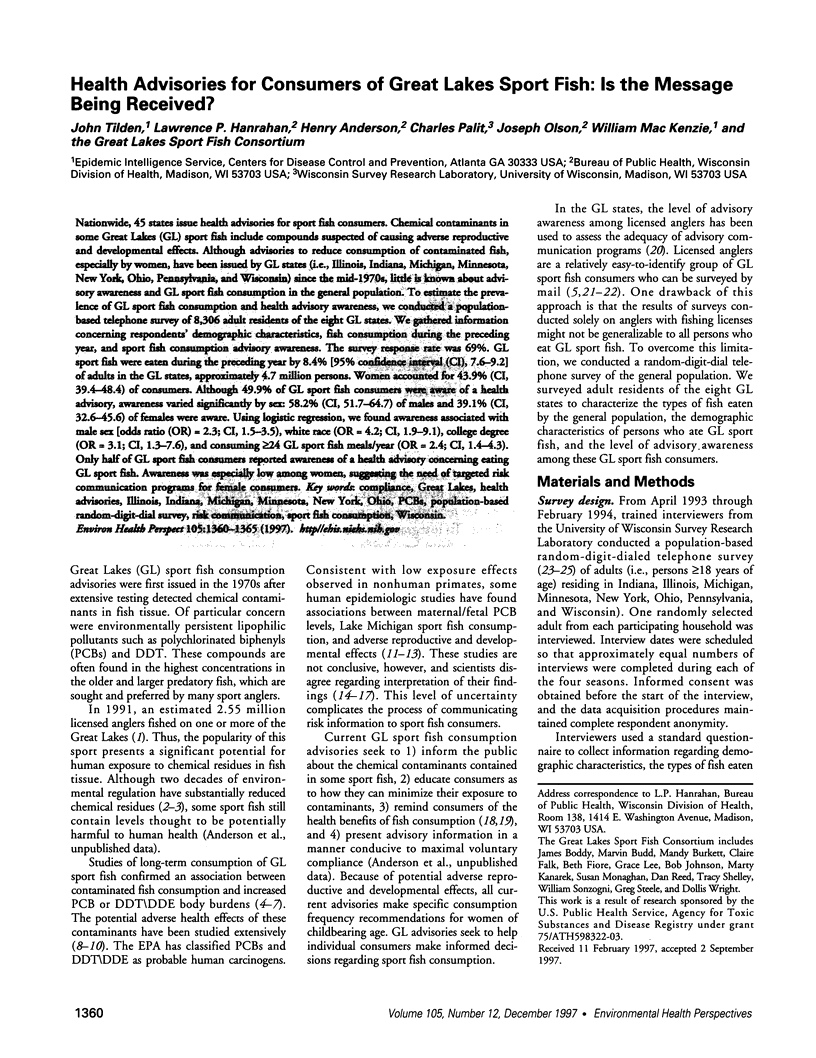
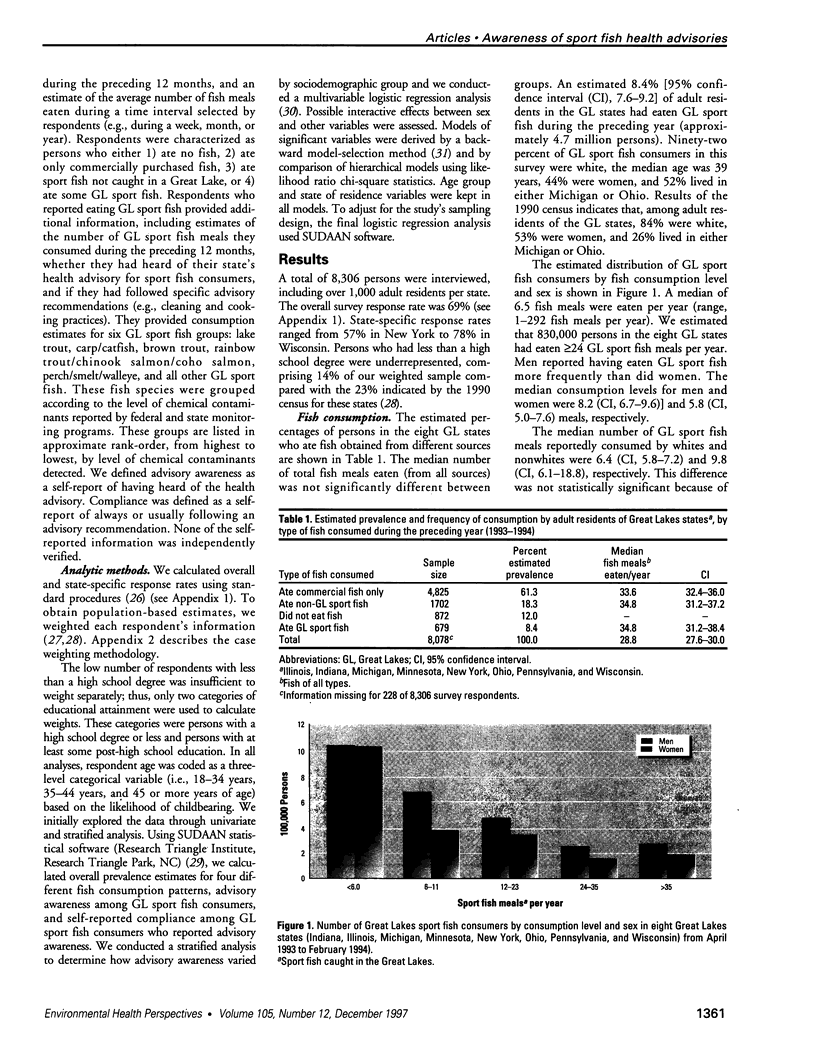
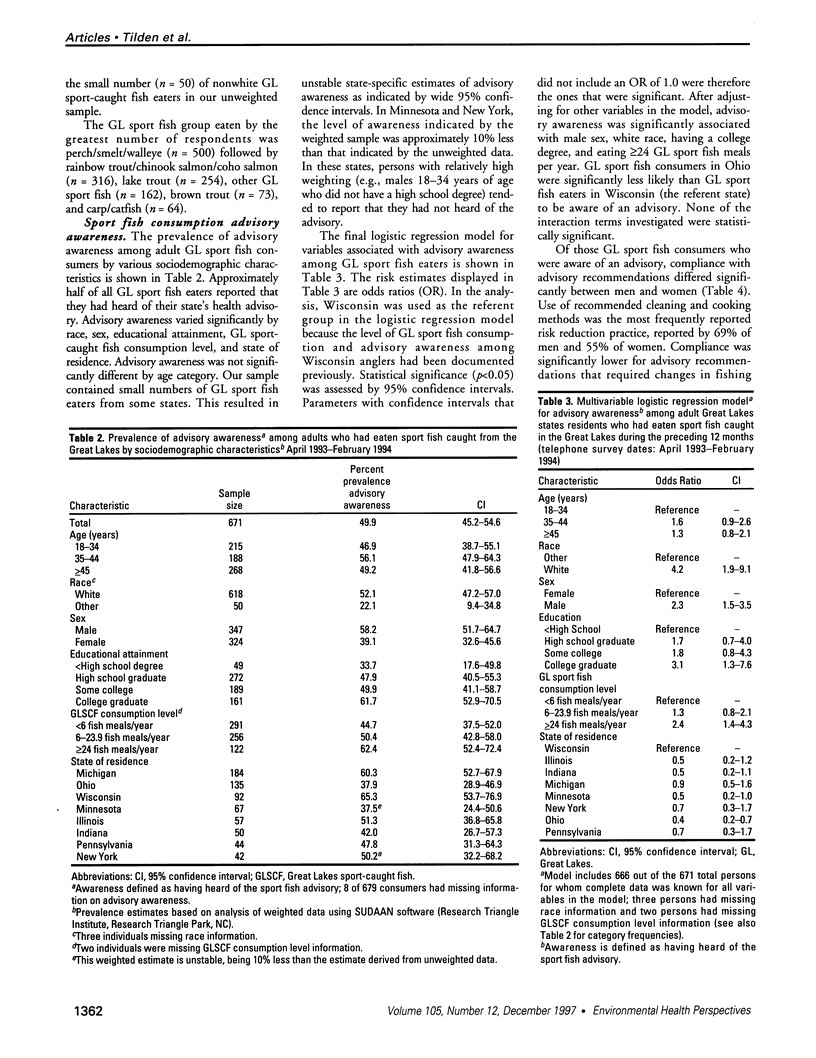
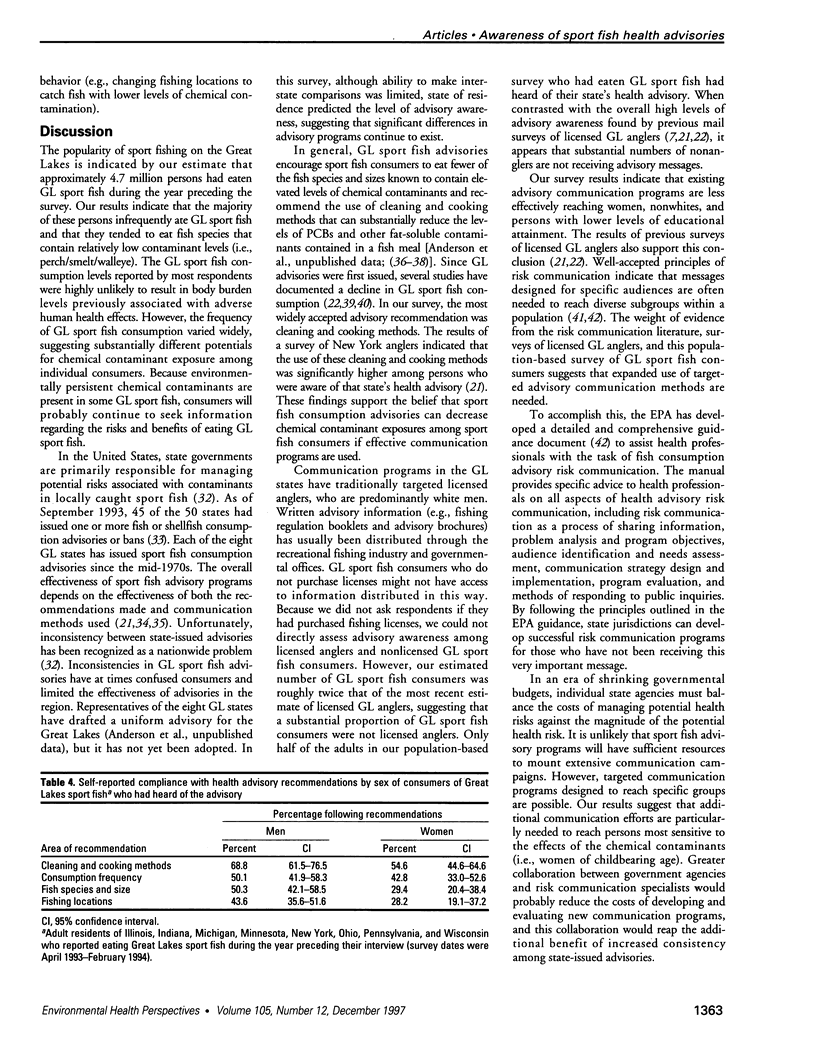
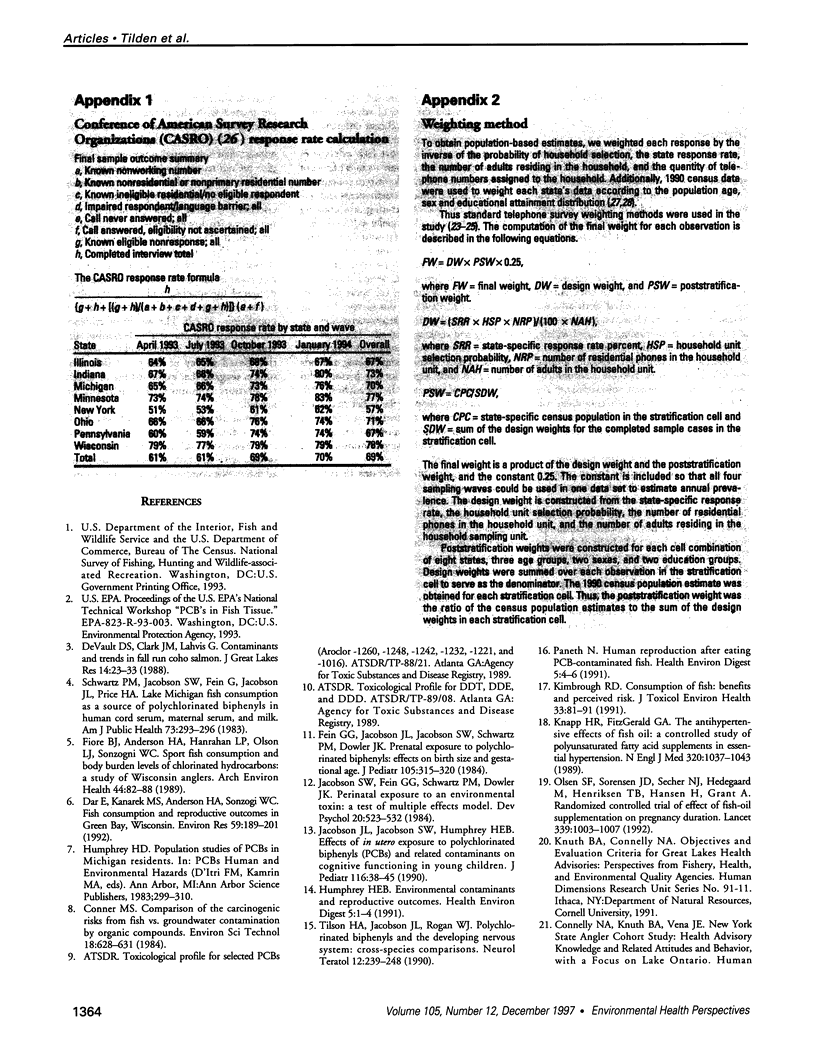
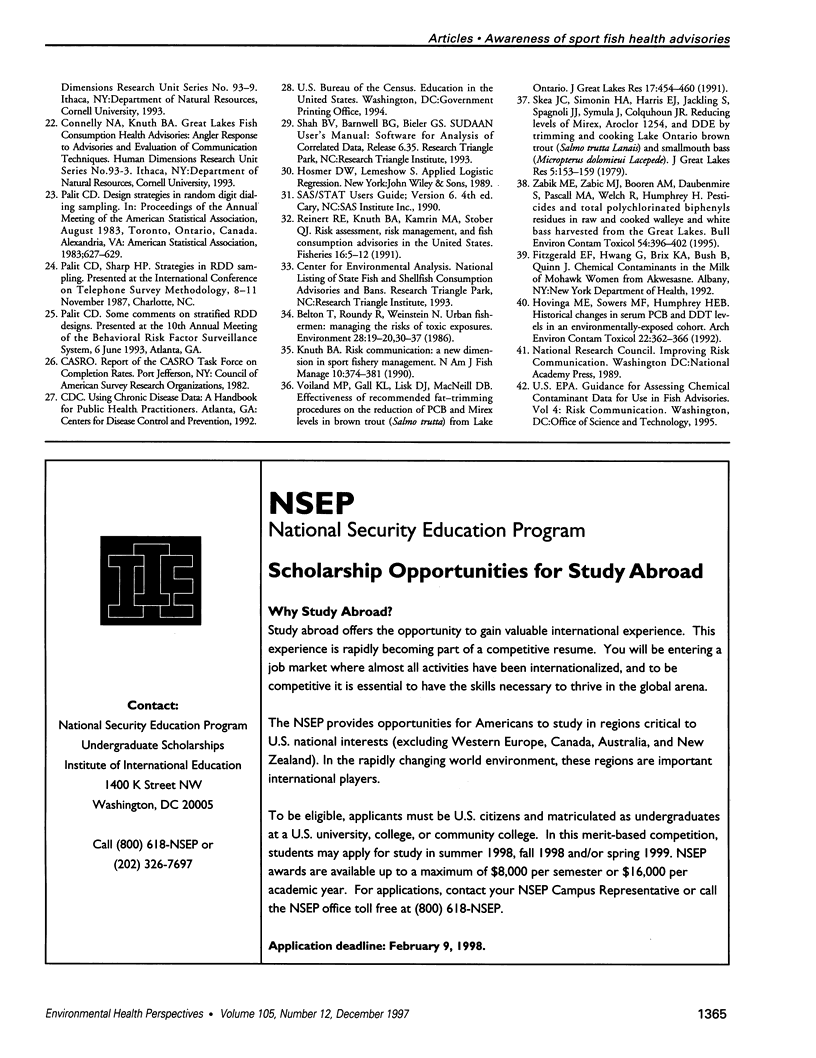
Images in this article
Selected References
These references are in PubMed. This may not be the complete list of references from this article.
- Dar E., Kanarek M. S., Anderson H. A., Sonzogni W. C. Fish consumption and reproductive outcomes in Green Bay, Wisconsin. Environ Res. 1992 Oct;59(1):189–201. doi: 10.1016/s0013-9351(05)80239-7. [DOI] [PubMed] [Google Scholar]
- Fein G. G., Jacobson J. L., Jacobson S. W., Schwartz P. M., Dowler J. K. Prenatal exposure to polychlorinated biphenyls: effects on birth size and gestational age. J Pediatr. 1984 Aug;105(2):315–320. doi: 10.1016/s0022-3476(84)80139-0. [DOI] [PubMed] [Google Scholar]
- Fiore B. J., Anderson H. A., Hanrahan L. P., Olson L. J., Sonzogni W. C. Sport fish consumption and body burden levels of chlorinated hydrocarbons: a study of Wisconsin anglers. Arch Environ Health. 1989 Mar-Apr;44(2):82–88. doi: 10.1080/00039896.1989.9934380. [DOI] [PubMed] [Google Scholar]
- Hovinga M. E., Sowers M., Humphrey H. E. Historical changes in serum PCB and DDT levels in an environmentally-exposed cohort. Arch Environ Contam Toxicol. 1992 May;22(4):362–366. doi: 10.1007/BF00212554. [DOI] [PubMed] [Google Scholar]
- Jacobson J. L., Jacobson S. W., Humphrey H. E. Effects of in utero exposure to polychlorinated biphenyls and related contaminants on cognitive functioning in young children. J Pediatr. 1990 Jan;116(1):38–45. doi: 10.1016/s0022-3476(05)81642-7. [DOI] [PubMed] [Google Scholar]
- Kimbrough R. D. Consumption of fish: benefits and perceived risk. J Toxicol Environ Health. 1991 May;33(1):81–91. doi: 10.1080/15287399109531507. [DOI] [PubMed] [Google Scholar]
- Knapp H. R., FitzGerald G. A. The antihypertensive effects of fish oil. A controlled study of polyunsaturated fatty acid supplements in essential hypertension. N Engl J Med. 1989 Apr 20;320(16):1037–1043. doi: 10.1056/NEJM198904203201603. [DOI] [PubMed] [Google Scholar]
- Olsen S. F., Sørensen J. D., Secher N. J., Hedegaard M., Henriksen T. B., Hansen H. S., Grant A. Randomised controlled trial of effect of fish-oil supplementation on pregnancy duration. Lancet. 1992 Apr 25;339(8800):1003–1007. doi: 10.1016/0140-6736(92)90533-9. [DOI] [PubMed] [Google Scholar]
- Schwartz P. M., Jacobson S. W., Fein G., Jacobson J. L., Price H. A. Lake Michigan fish consumption as a source of polychlorinated biphenyls in human cord serum, maternal serum, and milk. Am J Public Health. 1983 Mar;73(3):293–296. doi: 10.2105/ajph.73.3.293. [DOI] [PMC free article] [PubMed] [Google Scholar]
- Tilson H. A., Jacobson J. L., Rogan W. J. Polychlorinated biphenyls and the developing nervous system: cross-species comparisons. Neurotoxicol Teratol. 1990 May-Jun;12(3):239–248. doi: 10.1016/0892-0362(90)90095-t. [DOI] [PubMed] [Google Scholar]
- Zabik M. E., Zabik M. J., Booren A. M., Daubenmire S., Pascall M. A., Welch R., Humphrey H. Pesticides and total polychlorinated biphenyls residues in raw and cooked walleye and white bass harvested from the Great Lakes. Bull Environ Contam Toxicol. 1995 Mar;54(3):396–402. doi: 10.1007/BF00195111. [DOI] [PubMed] [Google Scholar]



